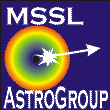

MSSL Astrophysics Group Beginner's Guides
Quasar Fly-by


Your starting point is hundreds of megaparsecs away from a distant spiral galaxy. As you move in you can see that there are different types of stars in the spiral arms and the central bulge of the galaxy - new, blue stars are found in the spiral arms, and old, red stars in the bulge. There are only 20,000 stars in this cartoon of a galaxy - a real galaxy like our own Milky Way has 100 billion - give or take a few. Notice that we have effectively `switched the quasar off' - real quasars are so bright that they completely outshine all 100 billion stars in the galaxy. In the centre of the galactic bulge, you can just make out the blue clouds which mark the outer regions of the quasar itself. Within these slow-moving clouds lies a doughnut-shaped region (a torus) of gas and dust, then much closer to the nucleus, a system of fast moving clouds (shown green and purple/yellow). Flying through these clouds, you reach the main `engine' of the quasar: a blue disc of gas which feeds a monstrous black hole.
From start to finish, your scale has changed by 10 orders of magnitude, in other words, the first frame in this animation covers a region 10 billion times larger than the last.
 Return to the
MSSL Astrophysics Group Visitor Centre
Return to the
MSSL Astrophysics Group Visitor Centre Mullard Space Science Laboratory
Mullard Space Science Laboratory Back to the
Mullard Space Science Laboratory homepage
Back to the
Mullard Space Science Laboratory homepage